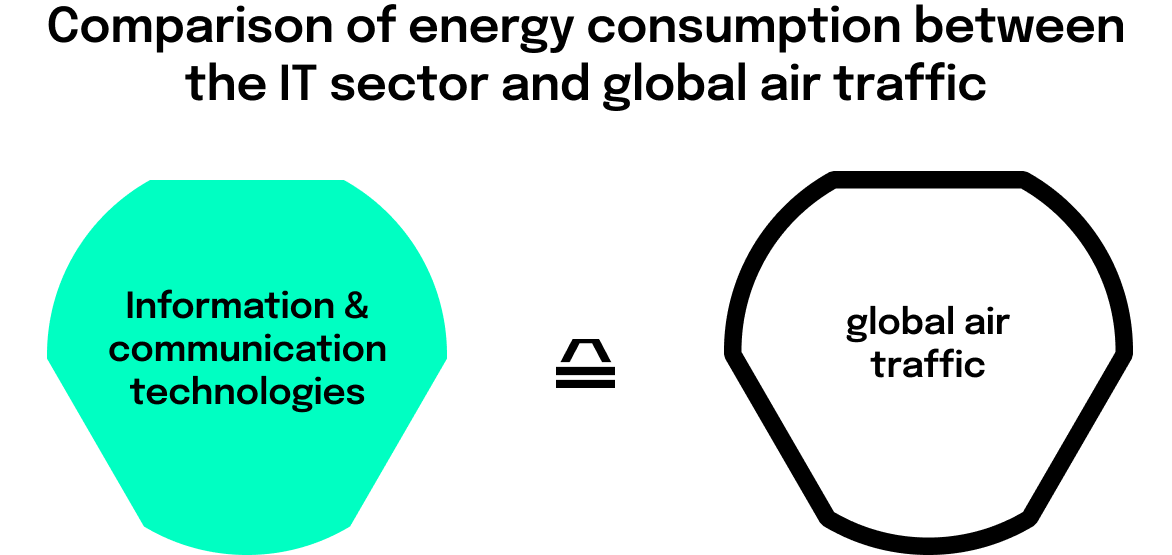Whether software or hardware, whether programmer or sales employee – a sustainable IT infrastructure in the company concerns everyone. In this article, we show why sustainable IT is not a trend for companies, but an absolute must for the future.

Whether software or hardware, whether programmer or sales employee – a sustainable IT infrastructure in the company concerns everyone. In this article, we show why sustainable IT is not a trend for companies, but an absolute must for the future.

Sustainable IT is more than just an email ending with: “Please do not print this email – for the sake of the environment!” The term describes the use of IT resources in such a way that the environmental impact is kept as low as possible.
One example is better to use one server at 100% capacity than three at one third each. Sustainable IT also means minimizing electronic waste, i.e. not always buying new hardware, for example, but renting it for short-term use (incidentally, this is possible with Grover, which we not only use ourselves at neosfer, but is also one of our portfolio companies). It can also include choosing between using a potentially more efficient cloud infrastructure and a controllable and transparent local operation. The type of electricity a company purchases can also be part of sustainable IT: Where and when can I run my software to potentially use surplus green energy?
At its core, sustainable IT is about reducing energy consumption through software. With software that is used millions of times over, even small, seemingly insignificant improvements can have a major global impact. This scaling effect should not be underestimated, even if there is still no standardized way of measuring the complex and non-transparent topic of sustainable IT.
When companies switch to sustainable IT, they start with a fundamental realization: digitalization can have a major positive impact on our carbon footprint and conserve natural resources. At the same time, everything digital automatically has a physical side, a carbon footprint.
Sustainability concerns should not fundamentally slow down digitization efforts, as the two go hand in hand. However, IT and companies in general need to become more aware of the impact that technological progress has on the environment and how negative consequences can be minimized. We at neosfer, Commerzbank’s early-stage investor and innovation unit, are in the middle of this learning process, as you can read below.
Sustainable IT should always be considered from an economic point of view. The good news is that sustainable IT solutions often mean cost savings anyway thanks to lower energy, hardware and operating costs.
Sustainable IT has many positive side effects for a company’s image: A company that focuses on sustainability increases its attractiveness for customers, partners as well as for current and potential employees – which can be a big plus in today’s competitive market for skilled workers. It also fulfills current – and possibly future – legal requirements. Being a pioneer in sustainability continues to be a unique selling point.
Incidentally, the issue is not entirely new. Energy-efficient IT has been the subject of discussion since the 1990s. Even back then, the blue “Energy Star” sticker was emblazoned on devices that met certain energy-saving standards at the time. However, it is only in recent years that the topic has gained significant momentum, driven in part by the growing awareness of environmental and climate protection movements, global protests and new regulatory frameworks such as the EU Energy Efficiency Directive.
Today, the topic of sustainable IT is much more relevant and far-reaching. For example, more and more infrastructure service providers are offering the option of checking your software’s emissions. The world’s most important companies are positioning themselves on the matter: members of the international Green Software Foundation, the world’s largest organization in this field, include tech giants such as Microsoft and Alphabet and financial institutions such as the Swiss bank UBS.
At neosfer, we have been looking at how we can make our IT infrastructure more sustainable for some time now. The most important first step for us – as for any company that wants to introduce sustainable IT – was and is to raise employee awareness. For a simple reason: Everyone can make a contribution. Similar to the scaling effect of software, even the smallest actions of individuals add up!
So we have offered a number of presentations and training sessions for the team and tried to raise awareness first. One way in which we explained the topic was this simple comparison: one hour of streaming is roughly the CO2 equivalent of driving 300 meters by car (although the figures vary a lot, so the number is more of an approximation).
Applied to the corporate level we i.e. try to convey that old emails or unused files consume energy, not just storage space. Or that video calls, such as with Google Meet and other tools, cause fewer CO2 emissions if it is carried out with low video quality.

In addition to raising the awareness of all employees, the process towards sustainable IT primarily requires the IT staff themselves. For starters, they need to analyze the current status of existing projects. After all, you can’t improve what you can’t measure. If you use a cloud infrastructure such as Microsoft Azure or the Google Cloud Platform, for example, there are dashboards that provide a rough overview of the consumption of existing projects. To find out what footprint a website causes when used by customers, you can use a freely accessible tool such as websitecarbon.com. The image below shows the current result for our own website which is already really good, but there is still room for improvement. Why don’t you do the test for your site(s), too?

Finally, long-term monitoring is needed so that changes can be compared over longer periods of time. It is necessary to be able to check whether set goals have been achieved. This is the next step for us at neosfer, for example.
Fun fact about software development: sustainability often ensures a better user experience. For instance, when a customer gets to where they wanna go in an app quicker, this potentially also helps to save energy. To a certain extent, sustainable IT is a question of mindset: the desire for a sustainable infrastructure should be incorporated into all decision-making processes. For example, if a feature has a very large footprint, you should ask yourself: is the feature indispensable or can the goal be achieved in another way? In order to be able to ask and answer such questions, sustainability is now also an issue when onboarding new IT specialists to the neosfer team – unlike IT training or apprenticeships in Germany, where the carbon footprint is still rarely part of the curriculum.
What works well for us is looking at examples of sustainable IT from other companies, checking out best cases and also talking to people and benefiting from their experiences. We have analyzed success factors and challenges and then only adopted what has a good chance of being implemented sustainably in our company – for example, the utilization of servers or the optimization of files to be loaded.
The introduction of sustainable IT in a company therefore has numerous ecological, economic and social benefits and is definitely not a trend, but a must for the future. Just think of the rapid developments in the field of artificial intelligence: According to the World Economic Forum the energy required to perform AI tasks is increasing by around 30 percent every year. That’s a lot. Such developments make it necessary for companies to prepare their infrastructure for the future now

As we have shown in this article, the first steps are not difficult at all. Companies do not need a comprehensive concept right away, but can and should start small. Because every contribution counts.
You are currently viewing a placeholder content from Brevo. To access the actual content, click the button below. Please note that doing so will share data with third-party providers.
More Information